Future mobility
Kakao Mobility: Unravelling KoreaŌĆÖs astounding growth in mobility sector
Tech-based mobility firm revolutionizes the concept and practice of Mobility as a Service (MaaS) in South Korea
By Oct 01, 2021 (Gmt+09:00)
long read
Most Read

It wouldnŌĆÖt be an exaggeration to say that South KoreaŌĆÖs mobility sector has undergone a period of rebirth in 2015 when the countryŌĆÖs first taxi-hailing app Kakao T Taxi came into existence. Kakao Mobility Corp., a mobility unit under the Kakao Group, was the creator of the revolutionary app that introduced the concept of a ŌĆ£mobility platformŌĆØ among Korean citizens.
Kakao T Taxi was one of the Kakao GroupŌĆÖs earlier successes of expanding the messenger-based platform into other business areas. Kakao Group is led by Kakao Corp., the developer of the countryŌĆÖs dominant mobile messenger KakaoTalk. After making entry into the taxi market, the mobility company widened the industry horizon quickly by launching driver, parking, navigation, interstate bus, shuttle bus, train, air travel as well as electronic bike services. No one would argue in Korea that Kakao Mobility is now the leading pioneer of Mobility as a Service (Maas) in Korea.
ŌĆ£We will not only minimize the mobility needs of people but will also address the mobility demands of goods and services. Kakao T app users will basically be able to order offices, cafes, gyms as well as cinemas for delivery to wherever they want,ŌĆØ said Kakao MobilityŌĆÖs chief executive Alex Ryu last November during the Kakao GroupŌĆÖs IF(kakao)2020 conference.┬Ā ┬Ā
Kakao Mobility, which spun off from Kakao Corp. in 2017, has now grown into a giant of its own with more than 28 million users. Its competitive edge and scalability have allowed it to receive a funding of 500 billion won ($421 million) in 2017 from a consortium led by TPG capital, and later from other investors such as the Carlyle Group, Google and LG.
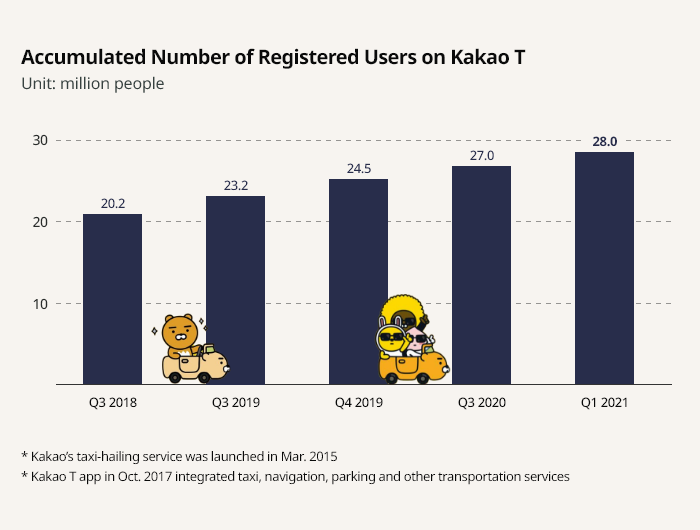
The company is currently valued above 4 trillion won ($3.4 billion) with an accumulated investment of more than 1 trillion won ($843 million). Its valuation based on the stock price in the over-the-counter (OTC) markets is about 8-9 trillion won ($6.7-7.6 billion). Investment banking sources reported that the National Pension Service (NPS) also joined as an investor when the TPG consortium and the Carlyle Group made additional investments in June this year.
Based on its success in the domestic market, Kakao Mobility has made inroads into other Asian countries. The company has partnered with JapanTaxi in 2018 and GrabTaxi in 2019 to allow South Koreans traveling in Japan and Southeast Asia to call local taxis using the Kakao T app. Kakao Mobility added that Kakao T, which currently offers booking services for domestic flights, will also make an expansion to include international flights in the near future.
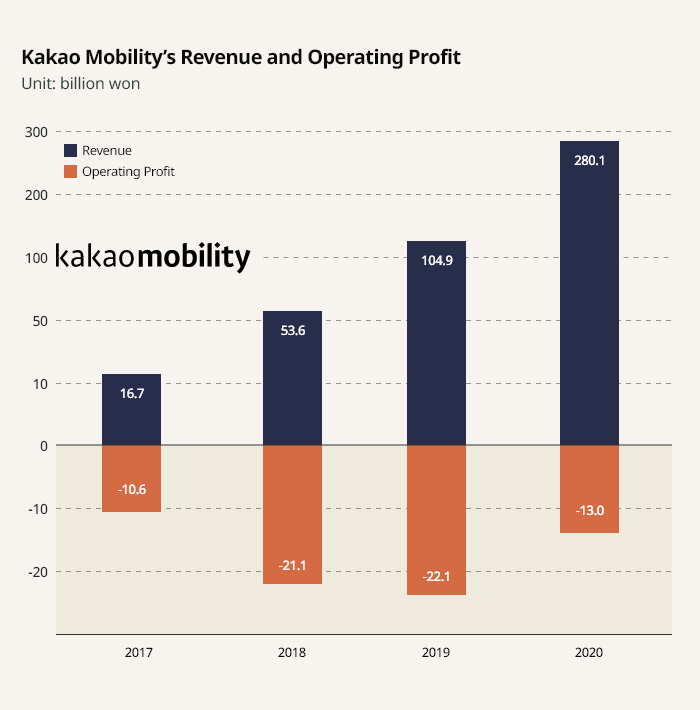
The Korea Economic Daily Global Edition (KED Global) has summarized the history of how Kakao Mobility has transformed the Korean mobility industry and the companyŌĆÖs long-term growth strategy into case studies as below.
(1) Innovation Story: Disrupting the South Korean Taxi Market
The South Korean taxi industry had a chronic issue that there were too many taxis due to the low entry barrier to the market. The oversupply problem was so grave that the government made an intervention in 2005 by introducing a ceiling on the number of taxis that each region of the country could operate.
Strangely, however, the citizens could almost never find the taxis when they needed them the most. Many tried to understand such a mismatch of supply and demand in the market. Neither the taxi drivers nor the users were satisfied with the system.
From the supply side, the issue was that the drivers refused to take the customers who wanted to move only for a short distance or to areas that were too remote and isolated. The quality of their service was nothing but awful with excessive speeding almost being a default. From the customer side, the main problem was that the demand was concentrated in only certain time periods during the day such as the rush hours and late at night.
It was such an environment when KakaoŌĆÖs mobility unit stepped into the market to solve the frustration of both sides. The company used technology to solve the problem: GPS-based data analysis tools and advanced matching algorithms to connect the drivers and the users. This was how the paradigm of the Korean taxi market shifted from road-hailing to app-calling.
The foremost area that Kakao Mobility focused on solving the chronic issue was the efficient allocation of the taxi vehicles according to the usersŌĆÖ real-time needs. It used big data analysis, as well as deep learning-based AI models to forecast regions and times of the day with high demand, to address the discord between supply and demand.
The Kakao T app users also note that Kakao Mobility was the pioneer in offering a much wider range of options in using taxis, by introducing Kakao T Blue that does not refuse the customers, Kakao T Venti that is a taxi van, and high-end taxi vehicles Kakao T Black.
The users agree that the most revolutionary of the options is Kakao T Blue. This particular taxi type solved the issue of ŌĆ£call-pickingŌĆØ by the taxi drivers, who typically refused to take the short-distance calls and those to remote, isolated areas. But Kakao T Blue uses an automatic allocation system that has helped solve the issue to a large degree. ┬Ā
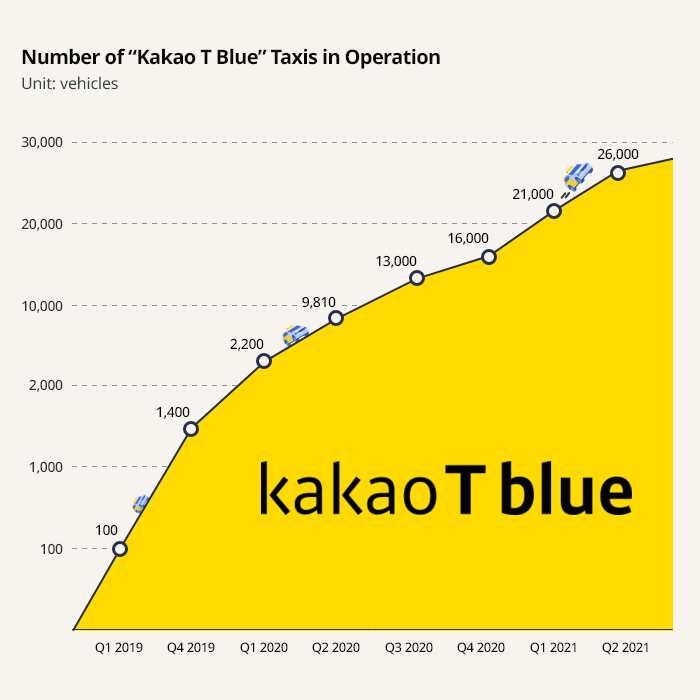
Kakao Mobility says that thanks to the allocation system, the acceptance rate of Kakao T Blue drivers was 78.5% between January and August this year, which means that 785 travels were run for every 1,000 calls made by the users. The figure is about 17 times that of the national average at about 4.5%.
In addition, Kakao Mobility also launched a number of systemic innovations for safer and more convenient rides such as the GPS-based taximeter, multi-calls, so-called ŌĆ£safe messages,ŌĆØ as well as auto payments. The GPS-based taximeter, unlike the typical mechanical taximeters, has allowed more flexible payment schemes based on real-time demand data as well as pre-arranged payment schemes. The multi-call system allows the users to call a large number of taxis at the same time within a given area.
The ŌĆ£safe messagesŌĆØ and ŌĆ£temporary safe numbersŌĆØ ensure safety for all taxi travels. The services allow the users to send the taxi vehicle and driver information to family and friends whenever they want and wherever they are using the KakaoTalk messenger.
Finally, the auto-payment option allows the users who have registered their credit cards on the Kakao T app to pay for the ride automatically after they have reached the destination. Kakao Mobility highlighted that the portion of the users who use the service increased to 56% as of the first week of February, up by 25 percentage points from the same period in 2020.
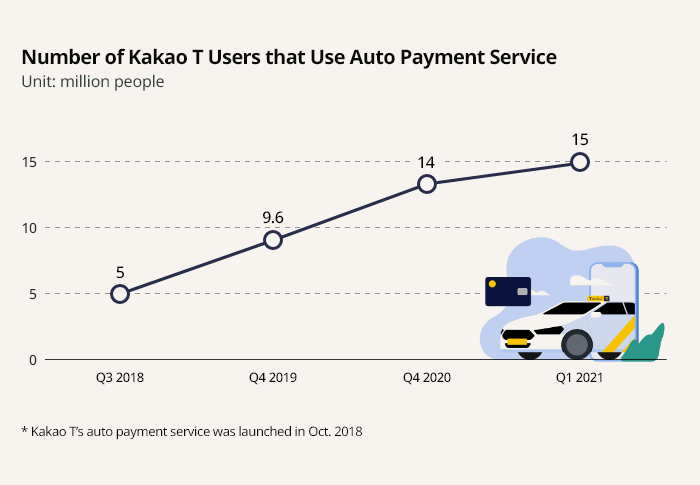
Improving the Taxi DriversŌĆÖ Work Environment
Kakao Mobility has also been ceaseless in making efforts to improve the working conditions of taxi drivers with a conviction that a better work environment will directly lead to the improvement of service quality for the users.
The company also persuaded the government to introduce a provisional taxi driverŌĆÖs license to allow the drivers to operate Kakao T taxis prior to receiving the official license if they have met certain conditions. Kakao Mobility added its real-time IT infrastructure also allows the drivers to manage their licenses more conveniently. ┬Ā
Kakao Mobility also advised the taxi companies that became member organizations under the Kakao umbrella to adopt a fixed-salary system over the traditional commission-payment system. The taxi drivers have been suffering from the commission-payment system where they must pay a disproportionately large sum of income to the taxi companies and keep only a small portion. The system had long been criticized by lawmakers and citizens alike as the main reason behind taxi driverŌĆÖs refusal to take certain users and excessive speeding.
But under a fixed-salary system, the drivers keep a fair, pre-agreed salary for more sustainable work life, which in turn provides a safer travel experience for the users. ┬Ā
Moreover, a mutual evaluation system between the drivers and the users on the Kakao T app provides safer travel experiences for both parties. Other measures that Kakao Mobility uses in maintaining clean and enjoyable taxi rides include regular education of the drivers as well as the best-performing driver awards given out annually. ┬Ā
(2) Tech Story: Industry-first Achievements with Technological Edge
Kakao Mobility believes that R&D is the key for improving the quality of its mobility services. Big data, network and autonomous driving technologies are at the core of its R&D agenda.
The WorldŌĆÖs First Commercialization of Fused Indoor Localization (FIN)
Kakao Mobility uses the fused indoor localization (FIN) technology on Kakao Navigation. The FIN technology utilizes 5G or LTE network signals to provide accurate navigation services where the GPS signals cannot reach. The company notes that the adoption marks the worldŌĆÖs first case of commercialization of FIN technology in car navigation.
Using FIN, the drivers can still be provided with accurate navigation services within tunnels or underground routes. Kakao Mobility offers FIN-powered navigation at more than 1,300 tunnels and underground roadways that are 500 meters or longer.
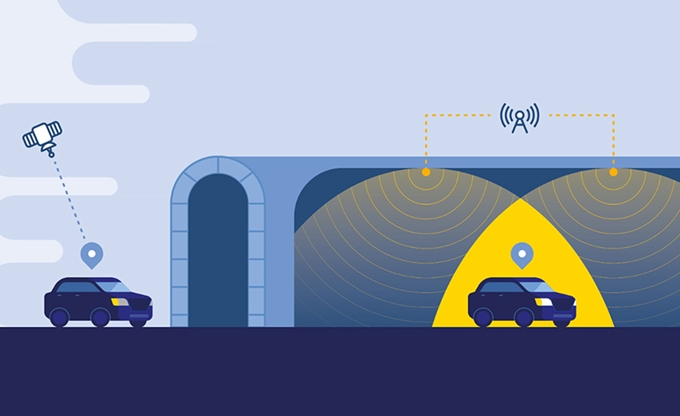
The company said that a technology called ŌĆ£pattern matchingŌĆØ was used in commercializing FIN. The pattern matching technology collects usersŌĆÖ LTE signal data from different geographic points first, saves such data in the map, and then compares them with the signal patterns of the users who are passing through certain points of the map. Such technology requires an immense amount of geographic data to ensure accuracy.
Kakao Mobility noted that its FIN-powered navigation has an error of 25-50 meters on average. In other words, the delay is only 1-2 seconds for vehicles traveling at 90 kilometers per hour.
Kakao Mobility ran a pilot service over a two-month period at SeoulŌĆÖs three major tunnels. The pilot project allowed the company to reduce the rate of route deviation by 30%, geographic positioning error within the GPS shadow areas by 26%, and time discrepancy by 9% during rush hours.

South KoreaŌĆÖs First Paid Service of Self-driving Vehicles
Kakao Mobility at the end of last year launched South KoreaŌĆÖs first autonomous vehicle booking service to a selected number of users in Sejong city. The users, using the Kakao T app, can call and book autonomous vehicles over three stopping points over a 4-kilometer distance near the cityŌĆÖs government complex. Kakao Mobility partnered with the autonomous driving solutions developer Autonomous a2z for the pilot project.
Aside from the partnership, Kakao Mobility has been developing its own self-driving technologies since Mar. 2020 when it received the Ministry of Land, Infrastructure and TransportŌĆÖs (MOLITŌĆÖs) preliminary approval to operate the autonomous vehicles.
Another milestone in the companyŌĆÖs journey in the field was participating in a government-wide technology innovation project for the commercialization of level 4 autonomous driving cars. A level 4 vehicle can move from one point to another without the driverŌĆÖs intervention. To this end, Kakao Mobility said that it has been working on developing AI technologies that can fully recognize the driving environment including the road, vehicles, traffic lights and passengers, make judgments, and control the vehicle movements at the same time.
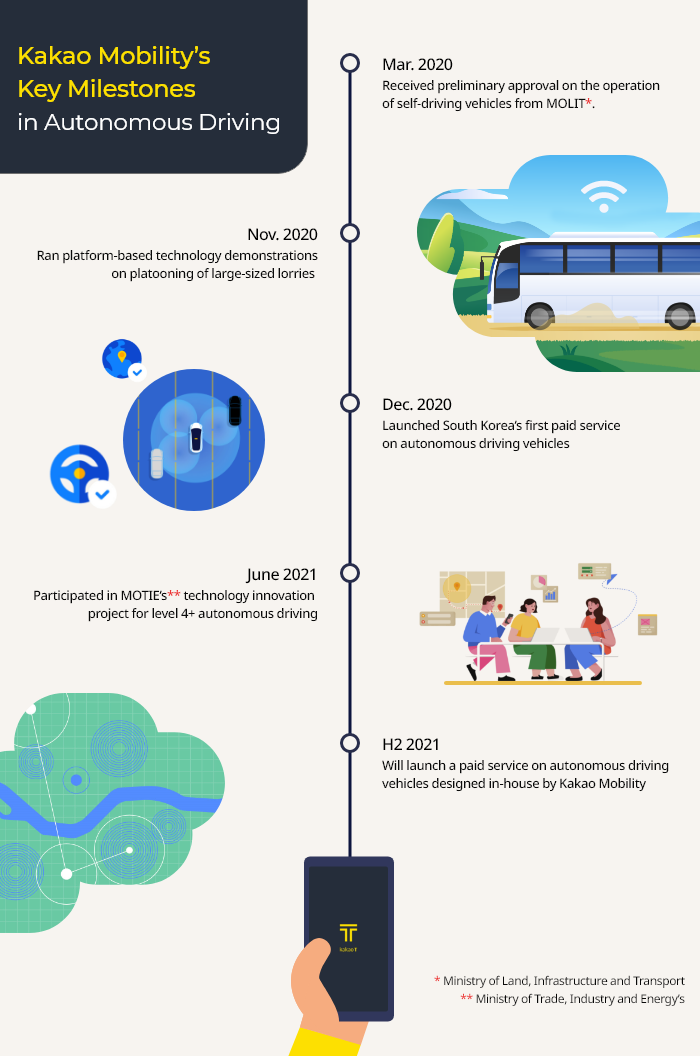
Big Data Analysis to Forecast Demand for Driver and Parking services
The big data collected from the users and drivers using the Kakao T app have allowed Kakao Mobility to make significant improvements in services.
Kakao TŌĆÖs driver service operates a data-based demand forecast system that allocates a greater number of drivers to the regions, days or time periods that are expected to have a surge in demand. At the same time, the service recommends the optimal range of price options for faster allocation of drivers. The company added that the system has cut inefficiency by reducing the time for drivers hovering in the streets looking for potential customers, while the users have much less chance in failing to find the drivers.
Kakao TŌĆÖs parking service offers an AI-based parking congestion forecast system, which also analyzes big data to show the expected level of congestion by the hour. The service also recommends the optimal time to leave for the parking lot by sending a message such as that the users should leave prior to a certain point of time if they want to avoid the congestion.┬Ā
ŌĆ£Our ultimate goal is to ensure that all our users feel convenient from the very beginning until the last second of their journey,ŌĆØ said a Kakao Mobility official.

(3) ESG Story: Leader in popularizing EV in South Korea
Kakao MobilityŌĆÖs late focus has been finding ways for more socially responsible management that can further benefit its 28 million individual users and 30,000 corporate users. Like the countryŌĆÖs leading firms Samsung Electronics Co. and SK Hynix Inc., the mobility company is now putting a particular level of effort in strengthening its presence in the environment, social and governance (ESG) sectors.
In the environment segment, Kakao Mobility has been a leader in popularizing electric vehicles (EVs) in South Korea. The company not only operates electric vehicle-specific shops for Kakao T Blue EV taxi drivers but has also signed an MOU in January with Kia Corp. to accelerate the use of EVs in the country. Under the deal, KiaŌĆÖs EV technology and infrastructure will be integrated with Kakao MobilityŌĆÖs platform.
Kakao Mobility will also start offering EV taxi solutions to taxi operators. The company added that the auto payment system is also eco-friendly in that it has significantly cut the use of paper receipts.
The company has also entered the EV charging and payment market by forming partnerships with charging point operators (CPOs), or companies that operate the charging stations. Kakao Mobility in April signed an agreement with the EV charging market leader Korea Electric Power Corp. (KEPCO) with a 9.6% market share.
Under the deal, Kakao Navigation will be connected to KEPCOŌĆÖs EV charging brokerage platform Charge Link. Specifically, the users of Kakao Navigation can find the charging stations on the app, which is also used as a means of payment.
In the social sector, Kakao Mobility is supporting the hearing-impaired citizens to become taxi drivers of the Goyohan Taxi, a taxi operator whose taxis are driven by the hearing-impaired drivers.
To improve the working conditions of the taxi drivers directly managed by Kakao Mobility, the company also signed an MOU with Shinhan Bank in April to offer tailored financial services including low-interest loans.

The company is also strengthening its profile in police and rescue segments. In 2016, it collaborated with the provincial police agency of the South Gyeonggi region to send rescue request messages to Kakao T taxi drivers in the area. Kakao Mobility said that criminals were arrested and rescue-seeking citizens were safely returned to home based on the cooperation. Kakao Mobility has expanded the scope of such partnership with the police force to nationwide, with an MOU in January this year.
Kakao Mobility was also a participant in the development of an emergency medical care system jointly led by the Ministry of Science and ICT and the National IT Industry Promotion Agency (NIPA). The company will develop an optimal vehicle navigation system for ambulances.
In the area of corporate governance, Kakao Mobility keeps a ŌĆ£hundred-to-zeroŌĆØ principle. Based on the principle, the company shares every management decision, or one hundred percent, to the employees and shares none, or zero percent, outside the company. ┬Ā
The parent firm Kakao Corp. has newly created its ESG committee in January this year based on board decisions. Kakao noted that the committee will oversee and manage the group-wide ESG strategy, key success cases as well as issues.
Write to Joo-wan Kim and Han-gyeol Seon at kjwan@hankyung.com
Daniel Cho edited this article.
More to Read
-

-
 ManagementKakao GroupŌĆÖs past, present and future as conglomerate
ManagementKakao GroupŌĆÖs past, present and future as conglomerateAug 17, 2021 (Gmt+09:00)
7 Min read -

-
 Future mobilityLG invests $88 mn in Kakao Mobility as both seek new growth opportunities
Future mobilityLG invests $88 mn in Kakao Mobility as both seek new growth opportunitiesJul 02, 2021 (Gmt+09:00)
1 Min read -
 Startup investmentsNPS joins in TPG-led $125 mn funding for Kakao Mobility
Startup investmentsNPS joins in TPG-led $125 mn funding for Kakao MobilityJun 10, 2021 (Gmt+09:00)
2 Min read -
 Future mobilityGoogle to buy $50 mn new shares in Kakao Mobility
Future mobilityGoogle to buy $50 mn new shares in Kakao MobilityApr 01, 2021 (Gmt+09:00)
2 Min read -
 Pre-IPO investmentCarlyle seals $200 mn investment in Kakao Mobility
Pre-IPO investmentCarlyle seals $200 mn investment in Kakao MobilityFeb 18, 2021 (Gmt+09:00)
3 Min read -
 Pre-IPOsGoogle to invest $270 mn in Kakao Mobility with Carlyle
Pre-IPOsGoogle to invest $270 mn in Kakao Mobility with CarlyleJan 29, 2021 (Gmt+09:00)
3 Min read -
 US, HK public funds join TPG-led group to co-invest $50 mn in Kakao Mobility
US, HK public funds join TPG-led group to co-invest $50 mn in Kakao MobilityFeb 21, 2018 (Gmt+09:00)
1 Min read
Comment 0
LOG IN




